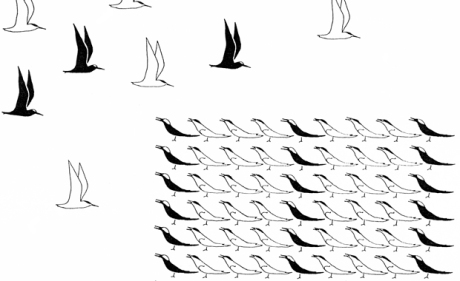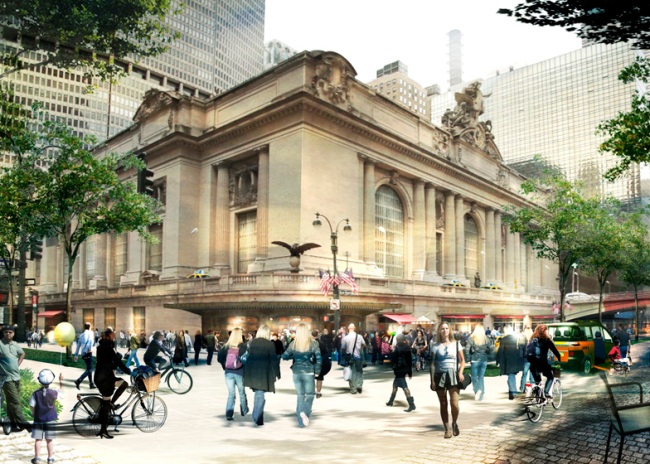Drawing Diversity October 4, 2013
Posted by jennibarrett in Uncategorized.Tags: aesthetics, architecture, drawing, landscape, UCLan
1 comment so far
Architects draw.
By hand or using technology tools, they make representations of a world they propose. Architects are also embracing site, context and landscape as essential parts of the architectural palette. Yet, despite artistic skills, well-honed in architecture school, there remains a divide between representation of buildings and the spaces that connect them. I remain unconvinced by out-of-scale, acid-green trees set in deeper-green, grass floor blankets.
Grand Central Terminal, New York (Foster&Partners)Source: http://www.dezeen.com/2012/10/19/foster-partners-present-vision-for-grand-central-terminal/
There is an ancient skill of deriving understanding of the natural world through artistic endeavour and we may be in danger of losing it. The great scientific contributions of Linnaeus and Darwin would not have been possible without drawing.
Vienna Dioscurides, A.D.515Source: Design Squish
It’s through the art of diagram that we understand the temporal and dynamic relationships between flora and their ecosystems.
Phylogenetic TreeA phylogeny-driven genomic encyclopaedia of bacteria and archaea
Source: Nature
And the spiritual and aesthetic human relationships with their built environment has been a repetitive theme in the literal and figurative fine arts for centuries.
Wanluan Thatched Hall, Dong Qichang, 1597Source: Wikipedia Ascanius Shooting the Stag of Sylvia, Claude Lorrain, 1682
Source: Wikipedia Commons Cityscape I (Landscape No.1), Richard Diebenkorn, 1963
Source: Wikipedia Commons
How do we define our relationship with the natural world, today? This is a daily question in architectural discussion, but there is little evidence of interrogating it through pen, pencil or mouse.
Masters students in architecture at UCLan, however, are interrogating landscape – looking at ways that architecture can understand the natural world a little better and engage with it in a little more depth. Their work will be exhibited next week and I’ll aim to pin up some inspiring images…….
Landscape Futures : Field Interventions July 2, 2013
Posted by jennibarrett in Uncategorized.Tags: architectural education, architecture, infrastructure, landscape, ruralism, UCLan, urbanism
add a comment
End of one academic year and headlong into the next……and the next one’s going to be a biggie.
The new Masters in Architecture course commences. I’ll be teaching one of the design ateliers with Prof. Karim Hadjri and we’ve been busy working it all out. So, now presenting in glorious RGB Technicolour……
Landscape Futures : Field Interventions
Landscape Futures Super-Workshop, Rina Kukaj
It’s an opportunity to expand our role and understanding of landscape within the architectural discipline as well as getting serious about the skills and knowledge we need to secure a sustainable urbanism and contextual architectural intervention. We’re still working out the finer points, but here’s a taster of what’s to come….
“How can architecture engage with concepts of food scarcity and energy security in the context of increasing urbanisation and rural decline?
How can technology engage with landscape to define an architecture of the future?
How do issues of infrastructure and aesthetics combine to produce sustainable urban futures that respond to ‘place’ and ‘time’?
The Landscape Futures atelier commences with a rapid-fire series of projects which investigate the flow and stasis of elements which define and determine urban and rural metabolisms including food, energy, biodiversity and transport. These issues will be explored at global and local levels and communicated in a variety of visual and tactile forms.
Semester 1 continues with exploration of precedents in the Netherlands and the north-west of England to establish temporal, spatial and aesthetic solutions and emerging challenges for architecture, focusing on the connectivity and symbiosis of urban existence with rural and agrarian productivity. This research will be used to generate strategies for a new and plausible urbanism for the Lancashire region based upon a deep understanding of how landscape and place interact with and determine architectural interventions in spaces of uncertain futures.

West8 Shell Project, Eastern Scheldt Storm Surge Barrier, Zeeland
“We are never going to save the rural places or the agricultural places or the wild and scenic places (or the wild species that dwell there) unless we identify the human habitat and then strive to make it so good that humans will voluntarily inhabit it.”
James Howard Kunstler
If you are interested in studying on the MArch at UCLan and joining us in this atelier or if you have any questions, please feel free to email me or use the form below.
I would also be really keen to hear from those interested in contributing to the atelier, either as a guest tutor, keynote speaker or as a case study.
RIP Preston Bus Station? #prestonsocial February 20, 2013
Posted by jennibarrett in Uncategorized.Tags: architecture, brutalism, Preston Bus Station
add a comment
On 26th February, I’ll be on the panel for a debate on the future/death of Preston Bus Station.
“Late Night Departure”
Source: Bernie Blackburn (Flickr)
The debate will form part of The Preston Social.
Details taken from Blog Preston:
“…….presenting an event giving those with an opinion on the future of Preston Bus Station an opportunity to discuss/debate/tweet with a panel of key figures and commentators to share views, answer questions and to amplify the passionate voice of Preston. The Bus Station conversation is one that has been going on for sometime in digital forums and spaces –
Panellists are:
Jenni Barrett – UCLan Architecture Lecturer. Researching psychology of collaboration. Foraging insights into culture of architecture. One time landscape architect.
David Coates – Southerner in the North. Journo (@leponline). Yeovil Town fan. I’d rather be Farmer Bill’s cowman.
John Wilson – Weather beaten, wise old owl. Ruffles feathers. A life in construction senior management. Football is my passion. Preston NE my team.
Councillor John Potter – Born in Whitehaven, Cumbria, Councillor John Potter moved to Preston to study in 2001. He became active in Preston politics in 2005 and have since stood and campaigned in a variety of ward seats. John was elected as a councillor for Cadley Ward on September 16 2010 in a by-election and was re-elected in May 2012 with more votes and a greater share of the 44% turnout. John is a voting Federal Conference rep for the Liberal Democrats as well as the secretary of the Wyre and Preston North local party and campaign coordinator for the Fulwood and Rural areas.
This is a great opportunity to have your views heard and speak to those who have a real interest in the bus station
The event is free, open to all and is organised by 3ManFactory supported by They Eat Culture.
What should happen on the night:
6.30pm-7.00pm – arrive, meet, mingle
7.00pm-7.05pm – Introductions
7.05pm-7.25pm – 5 min case/presentation per panelist
7.25pm – 8.30pm – Q&A
Date: 26 February
Time: 6.30pm to 8.30pm
Venue: The Snug – The New Continental, South Meadow Lane, Preston, PR1 8JP”
Join me by booking your free ticket here
I will, of course, tweet updates on the discussion & add a blog post summarising the event.
Virtues, Rules & Consequences: The ethics of designing buildings February 15, 2013
Posted by jennibarrett in Uncategorized.Tags: architecture, ethics, philosophy, professionalism, sustainability
4 comments
Architecture’s Diamond Jubilee June 1, 2012
Posted by jennibarrett in Uncategorized.Tags: architecture, history, jubilee
add a comment

–
A royalist I certainly am not, so today I hope you will join me in celebrations and jubilations at the architecture of 1952……no bunting necessary.
–
Unité d’Habitation, Le Corbusier





The Architectural Roman Nose May 25, 2012
Posted by jennibarrett in Uncategorized.Tags: architecture, evolution, ideas, meme
1 comment so far
The next few blog posts will be snippets of a study I did a few years ago looking at the evolution of ideas……
1 The Architectural Roman Nose………
The use of Darwin’s theory to describe apparent patterns of replication, variation and selection is a perennial theme in design, especially in the fields of architecture and the applied arts. The analogy has been applied to the evolution of artefacts and more specifically to traditional craftsmanship where generations of learning has inevitably incurred some random variation by nature of accidental misrepresentation or the trial and error involved in replicating a technique employed for long periods of time without the requirement for inventiveness.
However, in modern societies which adopt a more self-concious design process, a process of ‘heredity with copying’ is at work as new buildings and solutions are copied from preceding ones (see Philip Steadman’s book – The Evolution of Designs). This process is recorded not only in the more purposeful development of craft-based artefacts, as shown in this labour of love documenting the historical evolution of helmet designs……..

……but also in engineering solutions such as the motor car (c/o Le Corbusier).
We can look at building form in the same way. A particularly fecund idea (“I know, let’s stick it on pilottis!!”) breeds a whole family of buildings which transcend architectural ‘isms’ but fundamentally retain the genetically powerful characteristics. Hence, the pilotti becomes the architectural Roman nose.

Viral Crochet May 18, 2012
Posted by jennibarrett in General.Tags: architecture, crochet, house, ideas, meme
1 comment so far
Meme?
So what is this meme business?
I’m not trying to patronise, just attempting to kick start my brain out of it’s maternity leave mush. Consider this post as a bit of revision. So, we get the basic definition of a meme……why, thank you, Mr. Dawkins (The Selfish Gene)………building on William S. Burroughs “language is a virus“………as a unit for carrying cultural ideas, symbols or practices. Memes behave in a similar way to genetic material, through processes of replication, variation and selection in reponse to pressures exerted by the cultural environment.

However, consider architecture as a whole frenzy of memetic material vying for supremacy.
We might even consider the city as a giant memeplex (meme complex – groups of memes). Apparently, it’s where ideas have sex……really?!? (See thisbigcity.net).
Ask a child to draw a house.

Inevitably, they will draw a square, topped with a triangle. Maybe a rectangle chimney with spiralling smoke, even if they have a gas fire. 3 square windows and a rectangle door completes the image. We bring these to our creation of and understanding of architecture. Our minds are fuelled by more memes as we grow and are exposed to music, social networks, conversation, imagery and the grandaddy of all meme conduits – the tv. Oh and I forgot books – do people even still, like, read them?
The building and the city embodies these memes that flow, grow and become extinct without us even being aware of them. Perhaps, if we were aware of them, they’d be called ideas. Perhaps, if they changed the world, they’d be called culture.
The building is the physical manifestation of the Meme Cloud.
So, our revision complete, we can reiterate the focus of the Meme Cloud blog. I want to conciously express the unconcious memes and ideas, that may not traditionally be thought of as relevant to architectural or urban theory, but nevertheless shape or thoughts on how architecture should be created or appreciated. We will not be discussing the relative merits of the Doric vs. Ionic column, but perhaps there will be some mention of viruses and crochet.

Comment and offer memetic material
Orchestrating architecture May 19, 2010
Posted by jennibarrett in Uncategorized.Tags: architecture, drawing, interdisciplinary, multidisciplinary, music
1 comment so far
Goethe famously said that “architecture is frozen music.” The phrase is well worn and to be honest, I don’t think we really know what he was on about. Nevertheless, it asks us to look at the similarities between the two pursuits.
It occurs to many that there are numerous similarities between music and architecture, whether that be the creation of structure on which to hang it from or the rule-following of the styles and historic tradition. There is Classical Music and Classical Architecture. There is Baroque music and Baroque architecture too, and so on. And while we’re on the subject of rules, both artforms rely on mathematics to be communicated and executed.
Aha! It is the communication and execution of music and architecture that makes them so similar.
However, knowledgable of and skilled at painting we may consider ourselves, we will never have the opportunity to form a close relationship with the creator by assisting him in its execution. We can never hope for the chance to blob a bit of yellow on a sunflower for Van Gogh or chip a bit of stone off for Michelangelo. However, as a skilled musician, we may play a key part in executing the compositions of Bach or Beethoven. Similarly, the built environment professionals and craftsmen are placed to play a key part in executing the art of architecture.
It is recognised today, that the sharp contrasts drawn between the professionals, with the architect as chief artist is not conducive to creating great buildings in today’s industrial and cultural climates. The old ways that the architect communicated via clear specific drawings which must be obeyed at all costs, is not necessarily going to give us the best physical outcome.
And it is a musician that might help us think about a way forward.
In notating his “Concert for Piano and Orchestra,” John Cage dismisses formal orchestral notation in favour of a method which communicates his ideas, rather than the physical manifestation. He spaces out sound ‘events’ on the page and aurally, without notating a hierarchy that would define a specific aural outcome. This allows the performer to apply their own interpretation and the knowledge of their instrument to create the music. Cage, as the composer, has deferred control of the outcome whilst maintaining the intention. The boundaries between the disciplines and musical roles become blurred.

Can an architect defer such control? The architect, Daniel Libeskind has explored this. In “Chamber Works,” he uses graphic notations, rather than drawings, to communicate his architectural intentions. There is no clear demarcation of disciplinary input in the drawings. This allows the others involved in the execution of building to apply their own interpretation and specialist knowledge within the artistic framework.

The perception of professional boundaries becomes blurred, but this would allow all parties to subscribe to the artistic intention. If emotions of all those involved in the execution of the outcome are fully subscribed and engaged – as in the orchestra – then perhaps the outcome is more likely to invoke the emotions and appreciation of its audience. Similarly, architects will need to defer artistic control and expression to the executors of the outcome, if buildings are to become places of soul and emotion. Until, the framework for executing architecture replaces, at least in part, its emphasis on law, contracts and deliverables, then we can continue to expect buildings that are soulless but safe.












